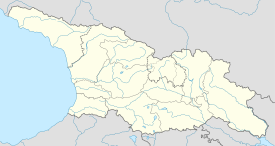David Gareja monastery
| David Gareji დავით გარეჯი Keşikçidağ |
|
|---|---|

The monastic complex of David Gareji.
|
|
| Basic information | |
| Location | Georgia |
| Geographic coordinates | 41°26′50″N 45°22′35″E / 41.4473°N 45.3765°ECoordinates: 41°26′50″N 45°22′35″E / 41.4473°N 45.3765°E |
| Affiliation | Georgian Orthodox Church |
| Region | Caucasus |
| Country | Georgia |
| Status | Active: Structures still in good condition; Dispute between Georgia and Azerbaijan over territory that part of the monastic complex sits upon. |
| Architectural description | |
| Architectural type | Monastic complex |
| Architectural style | Georgian; Monastery |
| Founder | St. David Garajeli |
| Funded by | Saint Ilarion during the 9th century, Georgian royal and noble families |
| Groundbreaking | 6th century |
| Completed | 6th century, 9th century |
David Gareja (Georgian: დავითგარეჯის სამონასტრო კომპლექსი, translit.: davitgarejis samonast'ro k'omp'leksi) is a rock-hewn Georgian Orthodox monastery complex located in the Kakheti region of Eastern Georgia, on the half-desert slopes of Mount Gareja, some 60–70 km southeast of Georgia's capital Tbilisi. The complex includes hundreds of cells, churches, chapels, refectories and living quarters hollowed out of the rock face.
Part of the complex is located in the Agstafa rayon of Azerbaijan and has become subject to a border dispute between Georgia and Azerbaijan. The area is also home to protected animal species and evidence of some of the oldest human habitations in the region.
The complex was founded in the 6th century by David (St. David Garejeli), one of the thirteen Assyrian monks who arrived in the country at the same time. His disciples Dodo and Luciane expanded the original lavra and founded two other monasteries known as Dodo's Rka (literally, "the horn of Dodo") and Natlismtsemeli ("the Baptist"). The monastery saw further development under the guidance of the 9th-century Georgian saint Ilarion. The convent was particularly patronized by the Georgian royal and noble families. The 12th-century Georgian king Demetre I, the author of the famous Georgian hymn Thou Art a Vineyard, even chose David Gareja as a place of his confinement after he abdicated the throne.
Despite the harsh environment, the monastery remained an important centre of religious and cultural activity for many centuries; at certain periods the monasteries owned extensive agricultural lands and many villages. The renaissance of fresco painting chronologically coincides with the general development of the life in the David Gareja monasteries. The high artistic skill of David Gareja frescoes made them an indispensable part of world treasure. From the late 11th to the early 13th centuries, the economic and cultural development of David Gareja reached its highest phase, reflecting the general prosperity of the medieval Kingdom of Georgia. New monasteries Udabno, Bertubani and Chichkhituri were built, the old ones were enlarged and re-organized.
...
Wikipedia

